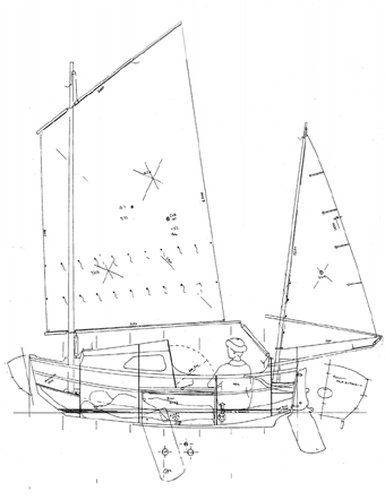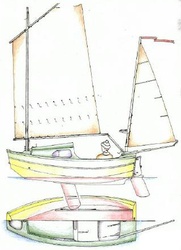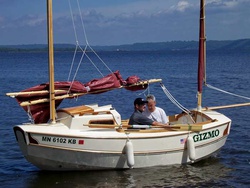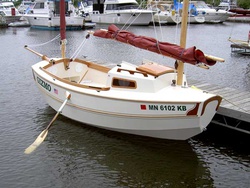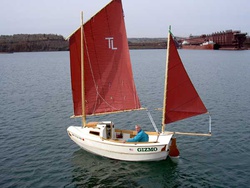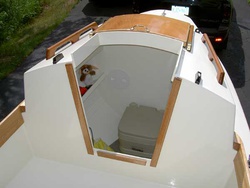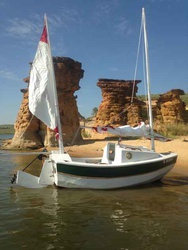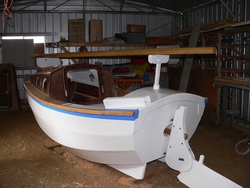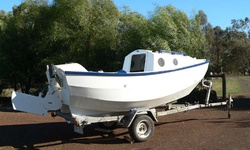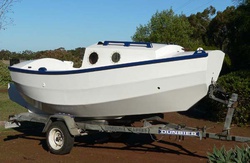Tread Lightly by John Welsford
The littlest practical cabin cruising yacht
| Length overall | ||
|---|---|---|
| Beam | ||
| Draft | ||
| Draft (cb up) | ||
| Berths | 1 | |
| Weight | ||
| Sail area | ||
| Hull construction | Plywood | |
| Gallery | 8 photos and 1 video | |
| compare | ||
URL: http://jwboatdesigns.co.nz/plans/treadlightly/
Description:
Length, a 15ft (4.5 m) long building space could accommodate a boat about 13 and a little bit feet (4 m) long and still allow the builder to get around the ends with the doors shut.
Imagine being up at the head of a deserted estuary, stuck there waiting out a couple of rainy days! I refuse to lock my customer in a tiny coffin like space for shelter so sitting headroom and adequate light for reading is a minimum. This means we need about 2m long x 0.75m wide x 1.050 m high at one end to accommodate our hypothetical average skipper. We may not be able to use the same space for both accommodation and sailing space so might need to do this twice over, but sitting up facing across the boat even a long legged sort needs only 1.200m of space from backrest to heel.
A month at 2 kg of food a day is 60 kg, this would include an allowance for stove and lamp fuel, with a weeks water at 3 litres a day the voyage consumables stores weight would be 81 kg. Given an 80kg skipper, 25 kg of ground tackle spread between two good sized anchors with some chain and 20 fathoms of nylon warp on each, an allowance of another 25 kg for clothing, pots and a camp stove we’re up to a bit over 200 kg (440 lbs) of “cargo” we have to carry.
A boat like this will be heavier than a typical dinghy of the same length but I expect about another 90 kg including the rig would do it. Given the tendency of cruisers to collect gear we should allow for 300 kg total displacement. That’s quite a lot for a dinghy of this size; she is to be as heavy as most day sailers with three crew so we need a buoyant and powerful hull.
Self righting, even the most carefully designed of ocean cruisers still has a narrow range of inverted stability, so the trick here would seem to be to get the stable range so narrow that she can be rolled up by her normal crew of one. To take a tip from “Maximum Exposure” we need to get some enclosed (buoyant) space high up relative to the hull. If possible we should have some weight low down and well secured so it contributes to the righting moment.
She should not have so much buoyancy tankage out near the gunwale that the skippers weight cannot sink one side to roll her, and the little cruiser should not have so much water in her when she rolls back to her feet that she is unstable due to free surface effect.
A securely watertight cabin and enclosed buoyancy chambers in the ends of the boat will do most of what we need with the buoyancy, at the helm the sailor needs only about 750mm in a fore and aft dimension if the full width can be used, water ballast would work but does tend to complicate the structure and is not particularly effective for the volume taken up. Perhaps some fixed ballast amidships? We can’t pick her up without a helping hand so another few kilos might not hurt. Lets draw this out and see.
Centreboard? They get in the road if they are in the middle, so why have it in the middle! Ok, an “offcentreboard!”
Storage. Hmmm, plenty of room and much of it can be amidships and low down, needs to be secure in a rollover or knockdown though.
An anchor space can be organised at each end so that wet and muddy ground tackle doesn’t need to be down below, auxiliary power, rowing I think would work fine for a boat of this size (suits Bill Serjeants Micro Sailboat class too) and anyone who wants an outboard can hang one on the back.
The rig? The rig! As the layout takes shape in my mind there is not room to put a mast in the usual place, no problem, I have in mind a rig that will allow the boat to be hove to head to wind so she can be reefed without having to hang over the side, a rig which will allow the sail area to be spread out and low, which can be used to help the boat self steer and which is simple and economical to set up.
A balance lugsail main and slightly larger than usual sharpie spritsail mizzen will do all of this; your choice for spars could be any one of alloy tube, bamboo, carbon fibre tubes, or wood. There should be one or another under the brother in laws house or somewhere else just as cheap.
Very much time to start the pictures so out comes the graph paper and pencil.
1. a pencil sketch is the first stage of the process, and is really just I thinking out loud and making notes. It shows the basic concept, layout and spaces.
2. from the above a drawing is made on graph paper so the proportions are more clearly defined. By using the graph paper I can map the sizes of each space required, I can work out the optimum spacing for frames and bulkheads, headroom, rough areas of sail and so on.
3. From drawing #2 comes the next stage, which is a drawing close enough to do calculations from. It is done on heavy polyester drafting film which can take much rubbing out, and the initial stages of the drawing work is done with “non copy blue” pencil, then 6h x .25mm propelling pencil, and finished off with .25mm tube nosed “Rotring Rapidograph “ pen using black “film” ink.
From this drawing calculations are made as to weights, stability, load carrying ability, centres of buoyancy, gravity, effort and lateral plane, Prismatic and block coefficients, sail area to displacement, water plane loading, water flow paths, foils, sail area and distribution, structural loads and how to carry them, ergonomics and economics, building method and on and on.
Of course previous experience makes a huge difference at this stage of a design, much of what I need is already to hand having designed boats of similar size and weights, building the occasional boat myself keeps me in touch with what is practically achievable with the materials so I end up with a boat that can be built without too much tearing out of hair.
4. Structure, all dimensions are taken off the #3 drawing so the dimensioning is consistent, any really odd joints are detailed, as are the bulkheads and frames. From this drawing on the development of a set of plans is a drafting function, Stuart Reid does this for me on my really big projects, the information is there in #3 but it requires time and application to produce the detail work from which the builders get the solutions to their many questions.
While the excitement is gone to some degree it is this stage of drawing that is the most important to the home boat builder, I was in a super yacht building company the other day, taking to one of my designer friends, he is employed solely to produce interpretations of plans and drawings of components from the designers originals. My customers can’t afford to hire him so we do the work here before the plans go out the door.
Now, how do we present this thing to the clients? So often it is the story illustrating the capability and possibilities of the design that sets people to thinking, a raw set of statistics and a profile drawing doesn’t grab the imagination so. Few people are able to make the leap from a few lines on paper to the mental imagery that would see them watching the sunset from the cockpit, so the next job is to write a story which will tell the reader just what it is that has just been set out on paper.
Photo gallery
Video gallery
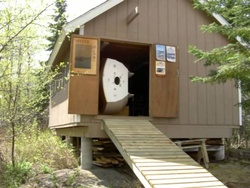
Building Tread Lightly with a modified and shortened cabin for day sailing. The boat is built with a built in electric trolling motor and oar ports to accommodate rowing the boat easily.
Boats about same size as Tread Lightly

|
Adelie 14
[AD14] A mini cruiser for coastal cruising and occasional short offshore passages
|

|
PocketShip
15-foot Fast-Sailing Pocket Cruiser with Sitting Headroom and 8-foot Berths
|
Questions? Suggestions? Contact us at: info@boatplans.cc
